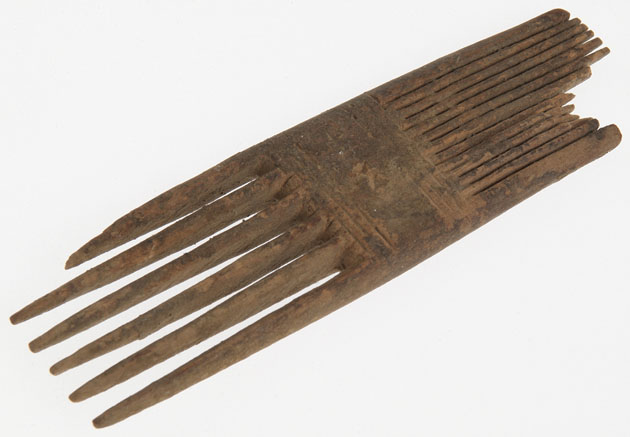Details
- Object type
comb
- Place Associated
Africa, Egypt, Middle Egypt, Antinoopolis (place found)
- Date
Coptic / Christian / Byzantine Period, 5th century AD
- Materials
wood
- Dimensions
overall: 142 mm x 40 mm x 10 mm 19 g
- Description
-
This narrow wooden comb has been made with two sides to serve two purposes. On one side it has been shaped with six coarse teeth for cosmetic purposes to comb the hair. The other side has been cut with eleven fine teeth between two broader outer ones which strengthen the edge of the comb. This side would have been used medically to delouse the hair. Hair lice were a common problem in ancient Egypt and were one of the reasons that wigs were worn, since lice cannot live on shaven heads or in the hair of a wig. It is possible that the matter still clogging these narrow teeth may include lice and their eggs surviving from the time the comb was last used.
The comb’s central zone has been decorated with three parallel lines incised along each set of teeth. In the middle of one side a Coptic cross has been cut. It has splayed arms of equal length in the form of a ‘Maltese’ cross. The comb was therefore made in the Christian or Coptic period in Egypt and has been dated to the 5th century. It was found at Antinoopolis and was given to Glasgow Museums in 1914 by the Egypt Exploration Fund, sponsor of the excavations there, which Glasgow Museums helped finance through membership of the Fund.
The city of Antinoopolis was founded by the Emperor Hadrian in 130 in memory of his lover, Antinous, who was drowned in the Nile there, and became the official centre of his cult. This comb is evidence for the Christian community that the city came to host. The substantial ruins of the Roman city survived into modern times and were recorded by Napoleon’s expedition to Egypt in 1798-1801. However, these ruins were subsequently destroyed by the villagers in the 19th century, who used the limestone masonry to feed the local cement works.
- Credit Line/Donor
Gifted by the Egypt Exploration Fund, 1914
- ID Number
1914.60.a
- Location
In storage
